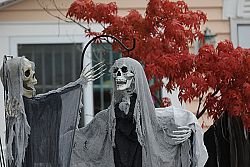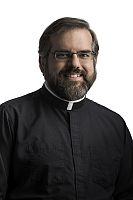A brief ecclesiology of celebrating Halloween
Fr. Christopher Gray
Sometimes people like to critique Christian feast days as being merely recapitulations of pagan festivals. Easter and Christmas come to mind, but connections to pagan celebrations for them are tenuous at best. All Saints Day, however, is an overt example of the Catholic Church baptizing of a pagan feast.
All Saints Day came into existence as a feast day in May, the feast of the dedication of the Pantheon in Rome as a Catholic church (and not merely a church for all the gods) and the placement there of the relics of the saints who had previously been in the catacombs surrounding Rome. That was in the year 609. About 150 years later, the feast day was transferred to its current day, the time of year of a popular Gaelic feast, Samhain.
For the Celts – a culture that grew from Ireland to coastal areas around Europe – Samhain marked the end of the year and the beginning of a new year with several days of celebration. This festival would capitalize on the liminal time between the old and the new year to raise awareness of the barrier between spiritual and material. The chaos of the festival became crystallized in the practice of masking and wearing costumes to become anonymous among the spirits, good or bad, living or dead, as well as using lanterns made from turnips or gourds.
During the celebration of Samhain, people would attempt to make contact with the spirit world so that departed relatives or other spirits would give guidance and inspiration for the new year that was starting. Our Halloween traditions are vestiges of this pagan festival. (Disclaimer: I am a huge fan of Halloween.)
When Christianity inculturates practices or things, we do so in a playful way. We love collecting idols; the Vatican Museum is full of them. We made the Pantheon a church of all the saints. We make the idol become decoration; likewise, in this case, we take the pagan belief away from the festivity and keep the best of the celebration, with Christian doctrine being given its due. Just like we do with Thanksgiving or Independence Day – American holidays we celebrate in Church not because they are holy in themselves, but because they are our celebrations – we state the eternal truths of our faith in the context of today.
So here’s doctrine contextualized, a brief Halloween ecclesiology: We are God’s holy people, and on All Saints Day we celebrate our holy brothers and sisters who make up the Communion of the Saints. The foul things about Halloween are not ours, purposefully – the ugliness, the scariness and especially the cheapness are parts of the celebration we might enjoy and laugh at – but in the end these are the parts that we discard quickly. Instead, what is ours is the splendid raiment of All Saints Day, a holy day of obligation this year: we celebrate the glory of heaven, the eternal beauty of God’s presence, enhanced by the multitude of the saints, the witness of grace triumphant. This splendor is where the saints are now; this is where we hope to be, along with all the holy souls we remember Nov. 2 and throughout this month. The decorations of Halloween are quickly swept away, just as we leave aside everything ugly, scary and cheap about sin in favor of Christian freedom.
Halloween is not an excuse for wickedness but an opportunity for holy diversion, baptized by faith, become leisure for the glory of the saints.
When our young ones (or not so young ones) take off their masks and costumes they’ll be doing a particularly holy work: Putting aside a falseness for a reality. Every day of our lives we try to do this, and we should be even more encouraged in celebrating all the saints: take off the masks and lay them aside. Just like how it is hard to see and breathe with a mask on, and much easier with it off, our souls live better when they are unhindered by the ugly, the scary and the cheap pretenses that we assume. Let us have our fun on Halloween, but, more importantly, may the Lord guard us from every evil thing to be worthy of the company of the saints forever.
Fr. Christopher Gray is pastor of St. Mary of the Assumption Parish in Park City and St Lawrence Parish in Heber.
© Copyright 2024 The Diocese of Salt Lake City. All rights reserved.



Stay Connected With Us